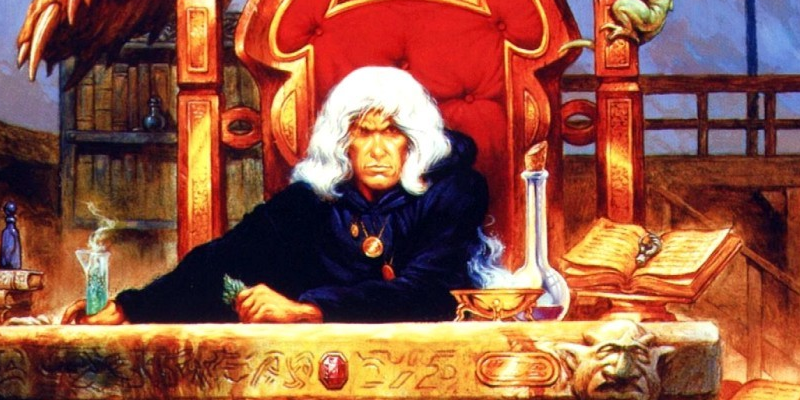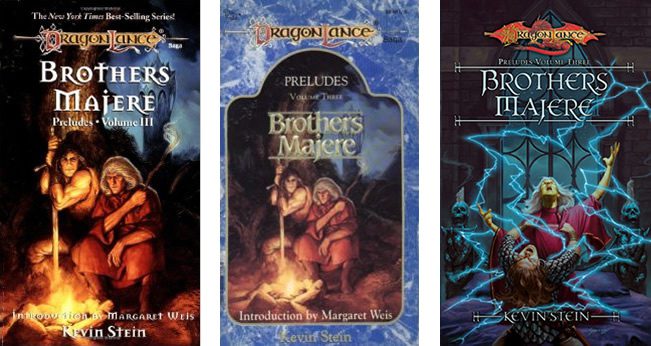Brothers Majere: The Dragonlance Book with Lich Sex

When I wrote about Lord Toede ages ago, I shared what I considered one of the more obscure and outlandish books in the Dragonlance novel library. In talking with some friends, I realized that while it was certainly bizarre, I totally forgot about a book from the Dragonlance Preludes series, Brothers Majere by Kevin Stein.
Dragonlance is a weird setting. It has many things we have come to consider Dungeons and Dragons staples, but it maintains a decidedly low-level approach to most of its content and characterizations.There is a specific style to Dragonlance established in the primary novels and source material. These provide a sense of consistency and a thematic throughline for the setting. This is particularly important when the core team spins off the work into the hands of other authors and designers. Usually, such style guides are referred to as a setting bible.
One of the most important elements is that magic is rare. Magic-users must undergo trials provided by the Conclave of Wizards, the governing body of magic-users, in the Tower of High Sorcery, in order to be a full-fledged wizard. Magic-users of little power are not called to the test, but powerful ones who refuse are branded renegades. The Conclave is supposed to act as an enforcement body for magic-users and all things magical. When strange artifacts are discovered, the Conclave should show up. When an event triggers powerful magical occurrences, the Conclave is supposed to be prepared. The Conclave as a magical government is one of the strongest pieces of design, because it carries a huge amount of story with it.

Unfortunately, this is the single most ignored item in all of Dragonlance, even largely by the creators when they returned to the setting. I sort of understand it. It’s a huge block to free-form storytelling. Every time you want to tell a magical story, you need incorporate the ruling body into the tale. This is actually awesome, in my view, and creates new and interesting hurdles to negotiate. The Dresden Files, for all of my own issues with the series, do a great job of this. You really feel like the White Council is a force in the world, and they appear with great frequency when magical situations occur. This is the same thing as in the Dragonlance series, but Butcher gives it a lot of follow-through.
Going back to Lord Toede for minute, why was there never a conclave wizard investigating in the blatant and bizarre magical occurrences Flotsam? It’s certainly possible there was and we didn’t see it, as the magical events occur in six month intervals, but you’d think for the last time around, when everyone has figured out the cycle, the conclave wizards would have been present. Certainly they should have intervened to take down a rogue wizard named Bob the Necromancer. Nary a peep, and this book was written by Jeff Grubb!
With My Brains and Your Looks, We Could Go Places
Anyway, Brothers Majere is a story of Raistlin and Caramon Majere, the popular twins from the Dragonlance Chronicles and Dragonlance Legends trilogies, a year after they left Solace, but four years before they make their way back to Solace. They are accompanied by a kender, largely attempting to recreate the dynamic between Tasslehoff and the twins, with the truly, truly unfortunate name of Earwig Lockpicker. They investigate the city of Mereklar, a mysterious place of mysterious mystery. As you might surmise, Brothers Majere is another prime example of the Conclave dropping the ball. However, what we get in return is a journey that is half Cats of Ulthar and half a noir detective film.
You see, Mereklar is a walled city of pristine, supremely magical white stone depicting the great stories of Krynn. What’s more, it appeared suddenly after the Cataclysm, and came with some prophecies. Cats were going to determine the fate of the world, and the Lord of Cats would lead them. There are also mentions of the first people, and the gods of good creating the city in the first place as a seal against evil.
To be fair, the Majere twins had to get on a boat and cross a sea to get to the town. Obviously this is why the Conclave didn’t investigate the shit out of this place. Wizards are notorious for saying, “Boats? Nah,” and then more or less going on with lives of cleaning up bat poop.
For the most part, the book is really a mystery, which I can get behind. Raistlin and Caramon are almost assassinated just after looking at a flier for a job posted in Mereklar. They find a mysterious magic item, they are offered patronage by a femme fatale by the name of Councillor Shavas, they are stalked by a man in black, and they contend with machinations both supernatural and political. The core mystery is that the cats of Mereklar are disappearing, sending the city into a panic. There were once thousands of cats in the city, but now there are hundreds and the number is still dwindling. These cats are supposed to save the world, remember.
Like all good noir stories, the book is on a tight timeline. The Festival of the Eye is about to occur, and this year all three moons will be in alignment on the same night. The Festival of the Eye celebrates a time when three wizards, each dedicated to different gods of good, evil, and neutrality, attempted to give their gods more power, but failed in the process. I am not really sure how this story makes a lot of sense, but another series of novels attempts to explain it. I am fairly certain this was a major setting event. Regardless, it becomes clear there is something extremely magical and dangerous happening in Mereklar, empowering ley lines so they are visible to any magic-user. Raistlin is granted a few insights into this process, and is certain they are in a time crunch to get this matter resolved.
That’s When the Dame Walked In
During the course of the novel, Raistlin and Caramon become enamored of Councillor Shavas. Regal, courageous, in need of saving, dark hair and sultry, she’s got everything a femme fatale needs. Now, here’s where the book gets a little…creepy. Shavas invites the three companions to her estate, and both twins think she is looking to get frisky with them. Raistlin, of course, doesn’t realize his eyes aren’t seeing her flesh decay, and Caramon is all about the ladies during every opportunity to get some action.
As a side note, I bet Raistlin had a wicked elf fetish. I guess Irda might qualify here, which reminds me that Dragons of Summer Flame is pretty incest heavy. I know it was resolved, but, man, maybe all of the Dragonlance books are actually super weird and I just didn’t realize it.
Anyway.
Caramon is pretty much mind-controlled by the blatantly magical nature of Councillor Shavas’ house, and goes into her bedroom and starts rifling through her undergarments. Really. Meanwhile, Earwig finds a magical ring telling him to put it on. Surprise, he also gets mind-controlled. While this is happening, Raistlin makes out with Shavas, and then the two of them play magical Risk. Shavas tells Raistlin she can’t go further with him because of servants. Classic femme fatale, always leave them wanting more.
During the course of the investigation, everyone is checking out Earwig’s magical necklace that Raistlin uses as bait, Earwig is confronted by a menacing, but seemingly benign, mysterious figure, and one of the Lords of the town attempts to kill him. However, the lords and ladies of the town are murdered, one by one, by this mysterious figure, who turns out to be extremely cat-like.
The book gets incredibly creepy when Raistlin decides to suggest Caramon invite Councillor Shavas out for an evening of food and sex, so Raistlin can have access to her library. Seemingly reading their minds, the Councillor invites Caramon out for sex, and lets Raistlin use the library. Councillor Shavas and Caramon have a sensual picnic, and then bone until morning. Raistlin, though jealous, is investigating the magical books in the library. He finds three books, one telling him about the Lord of Cats, though it paints the Lord of Cats as an evil figure. One talks about the city, in a pretty good use of in-world texts, and a good HP Lovecraft Necronomicon shout-out. The final one is a magical trap, which Raistlin knows is a trap, but decides to read anyway. It doesn’t make a lot of sense, but he defeats the trap, and then leaves the mansion.
There’s a Way to Lose More Slowly
It’s not a shock, then, as the mysterious figure is revealed to be Bast, the god of cats. Here we are, four years before the War of the Lance when the gods return to the world, and the god of cats is just walking around. Now, they claim him as a demigod in the book, but I can’t remember ever reading about another demigod in the Dragonlance novels. I could be wrong, of course, but this is some pretty weird stuff. Bast is problematic for a few other reasons, as well. First, Bast is the name of an Egyptian goddess, and the Egyptian pantheon is recognized in D&D. Sharess has Bast as an aspect in Forgotten Realms, if I am not mistaken. To make him a dude is a weird choice. Second, the book goes out of the way to say there are no other black cats within Mereklar. To make Bast the black man leading the violent gang of cats, and keeping out other black cats, is casually problematic in that way older fantasy so often is. I seriously doubt it ever occurred to the author, the editor, or the D&D team there might be an issue with this.
Earwig is growing increasingly evil and clingy to the twins, so Raistlin makes him go to sleep, but then he is kidnapped by Bast, unbeknownst to the twins. Bast reveals himself to the twins, and the two go investigate a tomb of a long-dead evil wizard. The long-dead wizard, probably the same wizard who wrote the in-world text Raistlin was reading earlier, gives Raistlin knowledge of a secret copy of the city that exists in the Abyss. This is yet another call back to the primary works, as the Temple of Istar was taken to the Abyss. Earwig tries to escape his prison, which is basically just like the Tomb of Huma, and tells stories on the giant magical art therein.
Another super weird choice is that when the Lords and Ladies of the city fight Bast in earnest, they all do so with wands. These wands are shaped like guns, and have a metal cap at one end, which blasts out the magical energy. It seemingly requires no magical ability to use them, only the desire to make someone dead. So there are literally shoot-outs occurring all over the city when they are trying to capture Bast. Raistlin actually shoots a guy in the back in cold blood. Though he suspects the Lord he shot was supernatural, it hasn’t been confirmed at this point. It’s quickly resolved without much drama, as Bast tells the twins the Lords and Ladies are all cat demons from the Abyss, but Councillor Shavas isn’t.
That’s Cemetary Talk
The climax of the book puts Caramon, Earwig, and Bast in the Abyss fighting cat demons, attempting to get to the center of the city to prevent Takhisis from coming out of the portal that exists where the Councillor’s house exists in the real world. This sounds like I forgot a bunch of steps to how this came to pass, but really that is how it is in the books, too. Don’t blame me, blame the 90’s. Caramon also gets his sword turned into a demon-slaying magical sword, but this never comes up again in any other book so, cool, I guess? Anyway, Earwig and Caramon murder a ton of cat demons who are trying to kill them with wand guns. Earwig discovers another magical ring protected by magical gems at an altar to Takhsis, a callback to the Green Gemstone Man and the Foundation Stone of setting lore, I guess? Magical spectral goddess hands guard the altar, but they don’t do anything at all. Earwig puts on the ring and asks the gate to open by accident, which was the secret to destroying the thing all along.
Meanwhile, Raistlin creates a magical poison he feeds to Councillor Shavas. This poison turns her own magical ability against her, and she explodes. This seems like a pretty incredible poison, and one that would have come in handy later in his life, but I guess he decided he was too cool to use it again. Before this happens, Councillor Shavas reveals herself as a powerful lich and really, really tries hard to have sex with Raistlin and get him to love her forever. Given the fact she had sex with his brother, this was a pretty strange ploy, but uh, liches be crazy.
The book concludes with Earwig getting a girlfriend, and Raistlin never telling Caramon he had sex with a lich. I guess there are some things even assholes won’t do. I like to think later on in life Raistlin saved it for a totally sick burn on his brother. Maximum impact was always his style, after all.
So there you go, a book where the Majere twins meet a god, and one of them makes out with a lich, while the other has sex with her. Also, they go to the Abyss and fight cat demons using wand-guns. What the ever-loving hell, 90’s fantasy? To bring the discussion all the way around, this story is entirely avoided, or changed dramatically, if the author and review staff had adhered to the setting bible. The Conclave would absolutely have been involved in a town like this – there is simply no way it would have escaped notice. Raistlin would have been playing cat and mouse against the authorities, attempting to toe the line, but also grasp magical power and further his own goals, all while trying to get to the bottom of the mystery. It would have been even more noir than the book already attempted to be, and it would have more closely hewn to the core tenets of the setting. Using the setting bible to tell stories so that each reinforces the other is paramount to good game play and game running.



